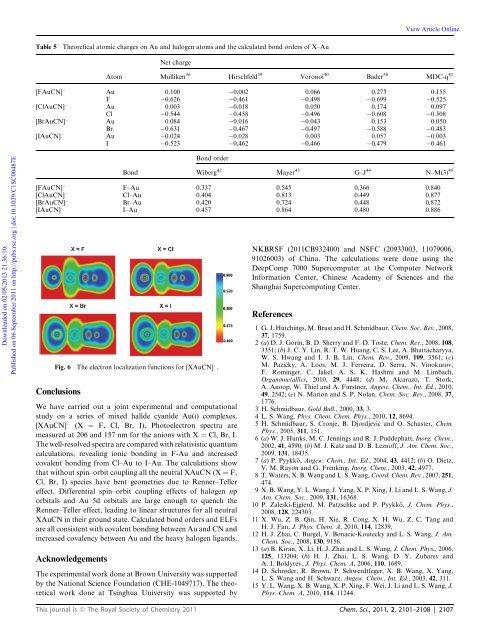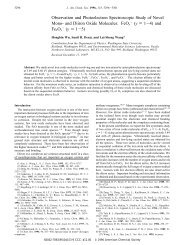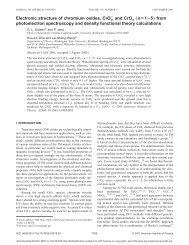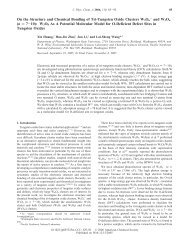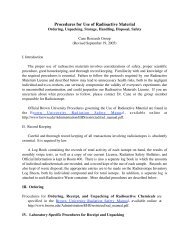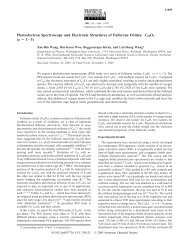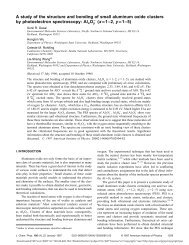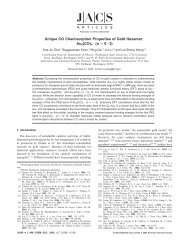Chemical Science EDGE ARTICLE - Chemistry Department at ...
Chemical Science EDGE ARTICLE - Chemistry Department at ...
Chemical Science EDGE ARTICLE - Chemistry Department at ...
Create successful ePaper yourself
Turn your PDF publications into a flip-book with our unique Google optimized e-Paper software.
View Article OnlineTable 5Theoretical <strong>at</strong>omic charges on Au and halogen <strong>at</strong>oms and the calcul<strong>at</strong>ed bond orders of X–AuNet chargeAtom Mulliken 36 Hirschfeld 39 Voronoi 40 Bader 38 MDC-q 41[FAuCN] Au 0.100 0.002 0.066 0.273 0.155F 0.626 0.461 0.498 0.699 0.525[ClAuCN] Au 0.003 0.018 0.050 0.174 0.097Cl 0.544 0.458 0.496 0.608 0.508[BrAuCN] Au 0.084 0.016 0.043 0.153 0.050Br 0.631 0.467 0.497 0.588 0.483[IAuCN] Au 0.024 0.028 0.003 0.057 0.003I 0.523 0.462 0.466 0.479 0.461Downloaded on 02/05/2013 21:36:10.Published on 06 September 2011 on http://pubs.rsc.org | doi:10.1039/C1SC00487EConclusionsWe have carried out a joint experimental and comput<strong>at</strong>ionalstudy on a series of mixed halide cyanide Au(I) complexes,[XAuCN] (X ¼ F, Cl, Br, I). Photoelectron spectra aremeasured <strong>at</strong> 206 and 157 nm for the anions with X ¼ Cl, Br, I.The well-resolved spectra are compared with rel<strong>at</strong>ivistic quantumcalcul<strong>at</strong>ions, revealing ionic bonding in F-Au and increasedcovalent bonding from Cl–Au to I–Au. The calcul<strong>at</strong>ions showth<strong>at</strong> without spin–orbit coupling all the neutral XAuCN (X ¼ F,Cl, Br, I) species have bent geometries due to Renner–Tellereffect. Differential spin–orbit coupling effects of halogen nporbitals and Au 5d orbitals are large enough to quench theRenner–Teller effect, leading to linear structures for all neutralXAuCN in their ground st<strong>at</strong>e. Calcul<strong>at</strong>ed bond orders and ELFsare all consistent with covalent bonding between Au and CN andincreased covalency between Au and the heavy halogen ligands.AcknowledgementsBond orderBond Wiberg 42 Mayer 43 G–J 44 N–M(3) 45[FAuCN] F–Au 0.337 0.545 0.366 0.840[ClAuCN] Cl–Au 0.404 0.813 0.449 0.877[BrAuCN] Br–Au 0.420 0.724 0.448 0.872[IAuCN] I–Au 0.457 0.864 0.480 0.886Fig. 6 The electron localiz<strong>at</strong>ion functions for [XAuCN] .The experimental work done <strong>at</strong> Brown University was supportedby the N<strong>at</strong>ional <strong>Science</strong> Found<strong>at</strong>ion (CHE-1049717). The theoreticalwork done <strong>at</strong> Tsinghua University was supported byNKBRSF (2011CB932400) and NSFC (20933003, 11079006,91026003) of China. The calcul<strong>at</strong>ions were done using theDeepComp 7000 Supercomputer <strong>at</strong> the Computer NetworkInform<strong>at</strong>ion Center, Chinese Academy of <strong>Science</strong>s and theShanghai Supercomputing Center.References1 G. J. Hutchings, M. Brust and H. Schmidbaur, Chem. Soc. Rev., 2008,37, 1759.2(a) D. J. Gorin, B. D. Sherry and F. D. Toste, Chem. Rev., 2008, 108,3351; (b) J. C. Y. Lin, R. T. W. Huang, C. S. Lee, A. Bh<strong>at</strong>tacharyya,W. S. Hwang and I. J. B. Lin, Chem. Rev., 2009, 109, 3561; (c)M. Pazicky, A. Loos, M. J. Ferreira, D. Serra, N. Vinokurov,F. Rominger, C. Jakel, A. S. K. Hashmi and M. Limbach,Organometallics, 2010, 29, 4448; (d) M. Alcarazo, T. Stork,A. Anoop, W. Thiel and A. Furstner, Angew. Chem., Int. Ed., 2010,49, 2542; (e) N. Marion and S. P. Nolan, Chem. Soc. Rev., 2008, 37,1776.3 H. Schmidbaur, Gold Bull., 2000, 33, 3.4 L. S. Wang, Phys. Chem. Chem. Phys., 2010, 12, 8694.5 H. Schmidbaur, S. Cronje, B. Djordjevic and O. Schuster, Chem.Phys., 2005, 311, 151.6(a) W. J. Hunks, M. C. Jennings and R. J. Puddeph<strong>at</strong>t, Inorg. Chem.,2002, 41, 4590; (b) M. J. K<strong>at</strong>z and D. B. Leznoff, J. Am. Chem. Soc.,2009, 131, 18435.7(a) P. Pyykk€o, Angew. Chem., Int. Ed., 2004, 43, 4412; (b) O. Dietz,V. M. Rayon and G. Frenking, Inorg. Chem., 2003, 42, 4977.8 T. W<strong>at</strong>ers, X. B. Wang and L. S. Wang, Coord. Chem. Rev., 2007, 251,474.9 X. B. Wang, Y. L. Wang, J. Yang, X. P. Xing, J. Li and L. S. Wang, J.Am. Chem. Soc., 2009, 131, 16368.10 P. Zaleski-Ejgierd, M. P<strong>at</strong>zschke and P. Pyykk€o, J. Chem. Phys.,2008, 128, 224303.11 X. Wu, Z. B. Qin, H. Xie, R. Cong, X. H. Wu, Z. C. Tang andH. J. Fan, J. Phys. Chem. A, 2010, 114, 12839.12 H. J. Zhai, C. Burgel, V. Bonacic-Koutecky and L. S. Wang, J. Am.Chem. Soc., 2008, 130, 9156.13 (a) B. Kiran, X. Li, H. J. Zhai and L. S. Wang, J. Chem. Phys., 2006,125, 133204; (b) H. J. Zhai, L. S. Wang, D. Y. Zubarev andA. I. Boldyrev, J. Phys. Chem. A, 2006, 110, 1689.14 D. Schroder, R. Brown, P. Schwerdtfeger, X. B. Wang, X. Yang,L. S. Wang and H. Schwarz, Angew. Chem., Int. Ed., 2003, 42, 311.15 Y. L. Wang, X. B. Wang, X. P. Xing, F. Wei, J. Li and L. S. Wang, J.Phys. Chem. A, 2010, 114, 11244.This journal is ª The Royal Society of <strong>Chemistry</strong> 2011 Chem. Sci., 2011, 2, 2101–2108 | 2107


